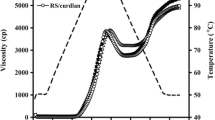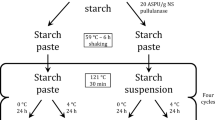Abstract
Retrograded and cross-linked resistant starches (RS) were prepared from rice starches through autoclaving-cooling cycles (RS3) and cross-linking using sodium trimetaphophate after annealing (RS4). The RS-added non-waxy rice starch gels were investigated to improve the gel structures of rice products. Rice starch (Nampyeong) isolated by an alkaline steeping method showed 24.25% of the amylose content. The RS levels of RS3, the citric acid added RS3 (CARS3), and RS4, and those of RS (10%) added gels were 9.05, 7.41, and 53.14%, and 3.52, 3.16, and 6.51%, respectively. However, rice starch with less than 12% starch concentration unlikely formed a gel network structure. RS was added to assist the rice starch in forming a gel structure, regardless of RS types. RS added starch gels showed significantly greater lightness, hardness, springiness, and gumminess than the control gel. It was found that RS improved rigidity and textural properties and increased dietary fiber level of gels.
Similar content being viewed by others
References
Lu ZH, Sasaki T, Li YY, Yoshihashi T, Li LT, Kohyama K. Effect of amylose content and rice type on dynamic viscoelasticity of a composite rice starch gel. Food Hydrocolloid. 23: 1712–1719, (2009)
Ring SG. Some studies starch gelation. Starch-Stärke 37: 80–83, (1985)
Tester RF, Morrison WR. Swelling and gelatinization of cereal starched. I. Effects of amylopectin, amylose, and lipids. Cereal Chem. 67: 551–557, (1990)
Miles MJ, Morris VJ, Orford PD, Ring SG. The roles of amylose and amylopectin in the gelation and retrogradation of starch. Carbohyd. Res. 135: 271–281, (1985)
Kim JO, Kim WS, Shin MS. A comparative study on retrogradation of rice starch gels by DSC, X-ray diffraction and á-amylase methods. Starch-Stärke 49: 71–75, (1997)
Liu Q, Thompson DB. Effects of moisture content and different gelatinization heating temperatures on retrogradatiion of waxy type maize starches. Carbohyd. Res. 314: 221–235, (1998)
Englyst HN, Kingman SM, Cummings JH. Classification and measurement of nutritionally important starch fractions. Eur. J. Clin. Nutr. 46(Suppl.): S33–S50 (1992)
Shu X, Jia L, Gao J, Song Y, Zhao H, Nakamura Y, Wu D. The influences of chain length of amylopectin on resistant starch in rice (Oryza sativa L.). Starch-Stärke 59: 504–509, (2007)
Eerlingen RC, Delcour JA. Formation, analysis, structure and properties of type III enzyme resistant starch. J. Cereal Sci. 22: 129–138, (1995)
Fässler C, Arrigoni E, Venema K, Brouns F, Amado R. In vitro fermentability of differently digested resistant starch preparations. Mol. Nutr. Food Res. 50: 1220–1228, (2006)
Åkerberg AKE, Liljeberg HGM, Granfeldt YE, Dres AW, Björck IME. An in vitro method, based on chewing, to predict resistant starch content in foods allows parallel determination of potentially available starch and dietary fiber. J. Nutr. 128: 651–660, (1998)
Fuentes-Zaragoza E, Riquelme-Navarrete MJ, Sánchez-Zapata E, Pérez-Álvarez JA. Resistant starch as functional ingredient: A review. Food Res. Int. 43: 931–942, (2010)
Zhang H, Jin Z. Preparation of products rich in resistant starch from maize starch by an enzymatic method. Carbohyd. Polym. 86: 1610–1614, (2011)
Ren C, Shin M. Effects of cross-linked resistant rice starch on the quality of Korean traditional rice cake. Food Sci. Biotechnol. 22: 697–704, (2013)
Song JY, Lee SK, Shin MS. Effects of RS-3 type resistant starches on breadmaking and quality of white pan bread. Korean J. Food Cook. Sci. 16: 188–194, (2000)
Lin JH, Wang SW, Chang YH. Effect of molecular size on gelatinization thermal properties before and after annealing of rice starch with different amylose contents. Food Hydrocolloid. 22: 156–163, (2008)
Pongjanta J, Utaipattanaceep A, Naivikul O, Piyachomkwan K. Debranching enzyme concentration effected on physicochemical properties and-amylase hydrolysis rate of resistant starch type III from amylose rice starch. Carbohyd. Polym. 78: 5–9, (2009)
Ozturk S, Koksel H, Ng PKW. Production of resistant starch from acid-modified amylotype starches with enhanced functional properties. J. Food Eng. 103: 156–164, (2011)
Rosalina I, Bhattacharya M. Dynamic rheological measurements and analysis of starch gels. Carbohyd. Polym. 48: 191–202, (2002)
Sodhi NS, Sasaki T, Lu Z-H, Kohyama K. Phenomenological viscoelasticity of some rice starch gels. Food Hydrocolloid. 24: 512–517, (2010)
Huang M, Kennedy JF, Li B, Xu X, Xie BJ. Characters of rice starch gel modified by gellan, carrageenan, and glucomannan: A texture profile analysis study. Carbohyd. Polym. 69: 411–418, (2007)
Song JY, Park JH, Shin M. The effects of annealing and acid hydrolysis on resistant starch level and the properties of cross-linked RS4 rice starch. Starch-Stärke 63: 147–153, (2011)
Mun SH, Shin M. Mild hydrolysis of resistant starch from maize. Food Chem. 96: 115–121, (2006)
Sang Y, Prakash O, Seib PA. Characterization of phosphorylated cross-linked resistant starch by 31P nuclear magnetic resonance (31P NMR) spectroscopy. Carbohyd. Polym. 67: 201–212, (2007)
AOAC. Official Methods of Analysis of AOAC Intl. 16th ed. Method 991.43. Association of Official Analytical Chemists, Gaithersburg, MD, USA (1995)
Lee HJ, Shin M. Comparison of the properties of wheat flours supplemented with various dietary fibers. Food Sci. Biotechnol. 15: 746–751, (2006)
Ott M, Hester EE. Gel formation as related to concentration of amylose and degree of starch swelling. Cereal Chem. 42: 476–484, (1965)
Tester RF, Karkalas J, Qi X. Review starch composition, fine structure, and architecture. J. Cereal Sci. 39: 151–165, (2004)
Mun SH, Shin MS. The effects of annealing on resistant starch contents of cross-linked maize starches. Korean J. Food Sci. Technol. 34: 431–436, (2002)
Author information
Authors and Affiliations
Corresponding author
Rights and permissions
About this article
Cite this article
Kim, J., Zhang, C. & Shin, M. Forming rice starch gels by adding retrograded and cross-linked resistant starch prepared from rice starch. Food Sci Biotechnol 24, 835–841 (2015). https://doi.org/10.1007/s10068-015-0108-x
Received:
Revised:
Accepted:
Published:
Issue Date:
DOI: https://doi.org/10.1007/s10068-015-0108-x




